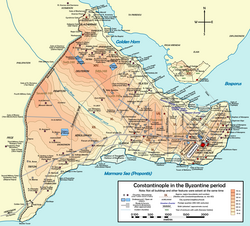Massacre of the Latins

The Massacre of the Latins occurred in Constantinople, the capital of the Byzantine Empire, in 1182. It was a large-scale popular massacre of all "Latin" (Western European) merchants and their families, who by that time dominated the city's financial life.
Since the late 11th century, Western merchants, primarily from the Italian city-states of Venice, Genoa and Pisa, had secured large-scale trading concessions in the Byzantine Empire, and had been allowed to establish their own quarters in the northern part of Constantinople, towards the Golden Horn. Relations between the Latins and the Byzantines were strained however: the Byzantines resented the Westerners' new wealth, eminence and arrogance, while the latter viewed the Byzantines as schismatics and degenerate. The relation was further complicated by the arrival of the Crusades, whose march through Byzantine territory was often accompanied by looting, and whose new principalities were at odds with Byzantine attempts to control them.
During the reign of the Latinophile emperor Manuel I Komnenos, relations improved markedly, although popular discontent increased, as the Italians came to dominate trade. Venice especially posed a serious challenge to imperial authority.[1] In 1171, Manuel I ordered the arrest of all Venetians in the Empire, and henceforth, the two states were at war. The Genoese and Pisans however profited from these developments, and by 1180, it is estimated that up to 60,000 Latins lived in Constantinople.[1] Following the death of Manuel I, his widow, the Latin princess Maria of Antioch, acted as regent to her infant son Alexios II Komnenos. Her regency was notorious for the favoritism shown to Latin merchants and the big aristocratic land-owners, and was overthrown in April 1182 by Andronikos I Komnenos, who entered the city in a wave of popular support.[1] Almost immediately, the celebrations spilled over into violence towards the hated Latins. Although Andronikos himself had no particular anti-Latin attitude, he allowed the massacre to proceed unchecked.[2] The massacre was indiscriminate. In the words of Warren Carroll, it was "a nightmarish massacre of thousands in which the slaughterers spared neither women nor children, neither old nor sick, neither priest nor monk. Cardinal John, the Pope's representative, was beheaded and his head was dragged through the streets at the tail of a dog; children were cut out of their mother's wombs; bodies of dead Westerners were exhumed and abused; some 4,000 who escaped death were sold into slavery to the Turks."[3]
The massacre further deteriorated the image of the Byzantines in the West, and although regular trade agreements were soon resumed between Byzantium and Latin states, the underlying hostility would eventually lead to the brutal sack of the city by the Fourth Crusade in 1204.[3]
References
- ^ a b c The Cambridge Illustrated History of the Middle Ages: 950-1250, Cambridge University Press, 1986, ISBN 9780521266451, pp.507-508
- ^ Harris, Jonathan (2006). Byzantium and the Crusades, ISNB 9781852855017, pp. 111-112
- ^ a b Carroll, Warren (1993). The Glory of Christendom, Front Royal, VA: Christendom Press, pp. 157, 131.
